Chipotle Mexican Grill started in 1993 with a single restaurant and now operates in 2,400 locations, including in Canada, England, France, and Germany. The
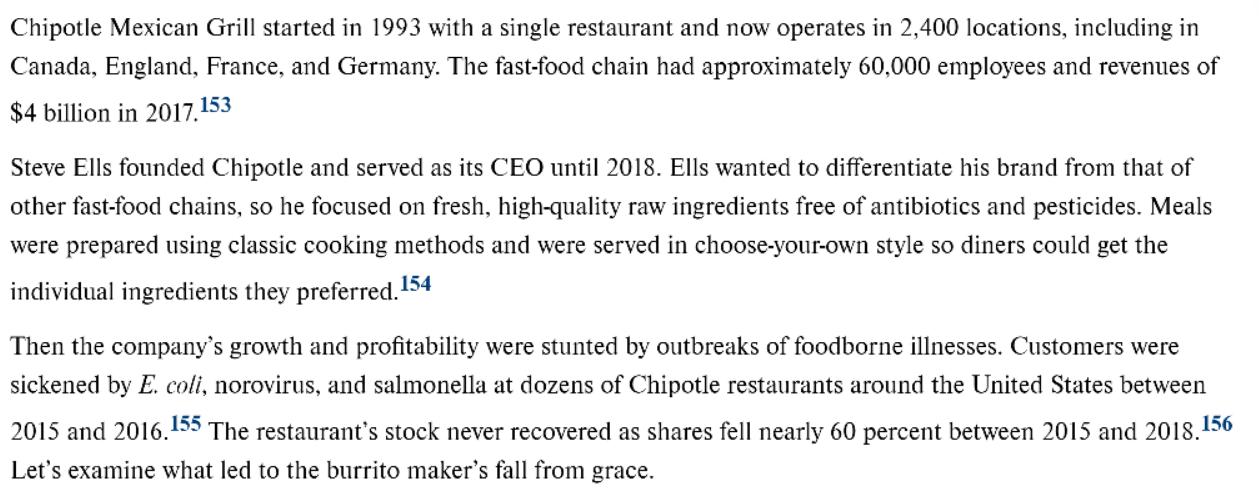
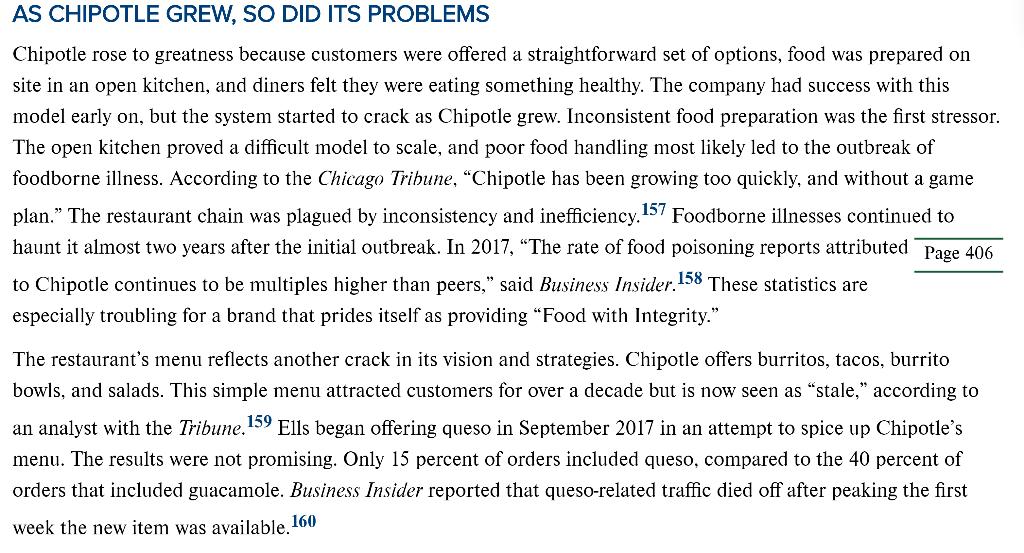
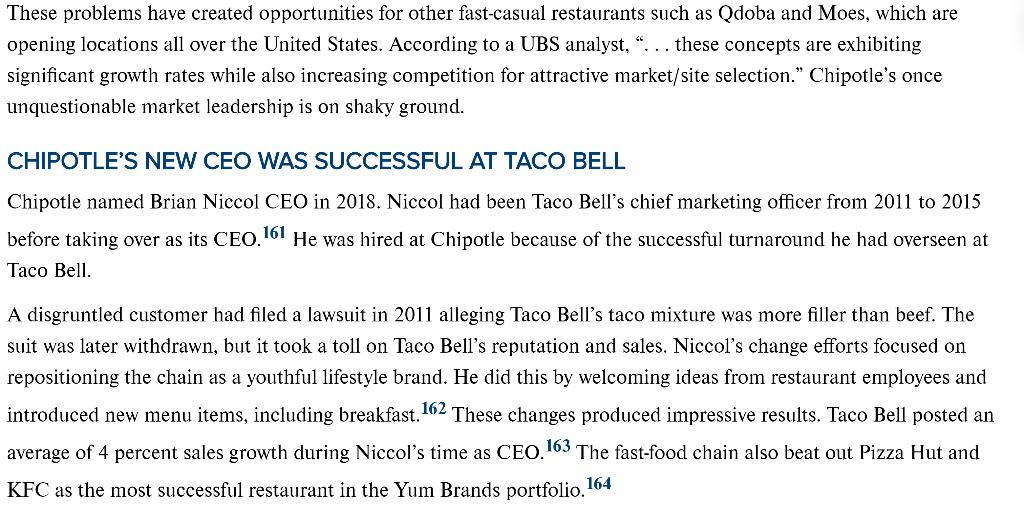
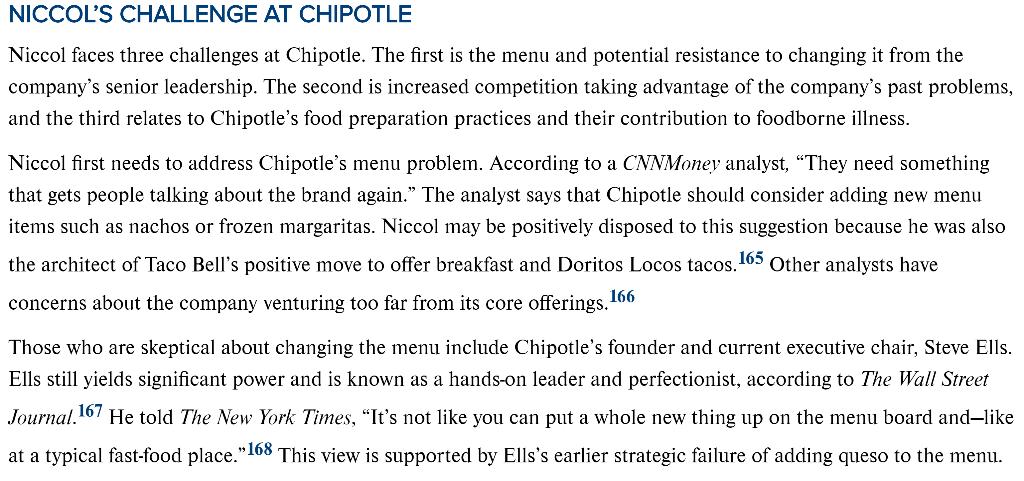

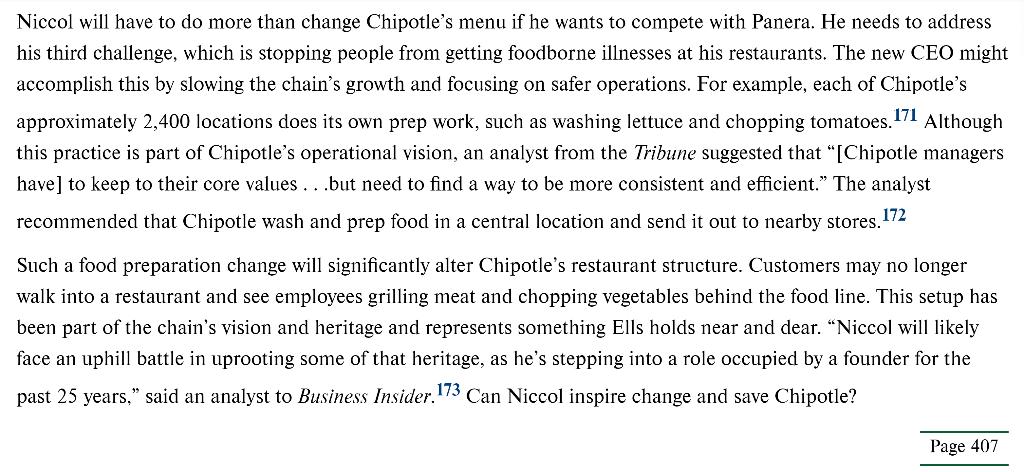
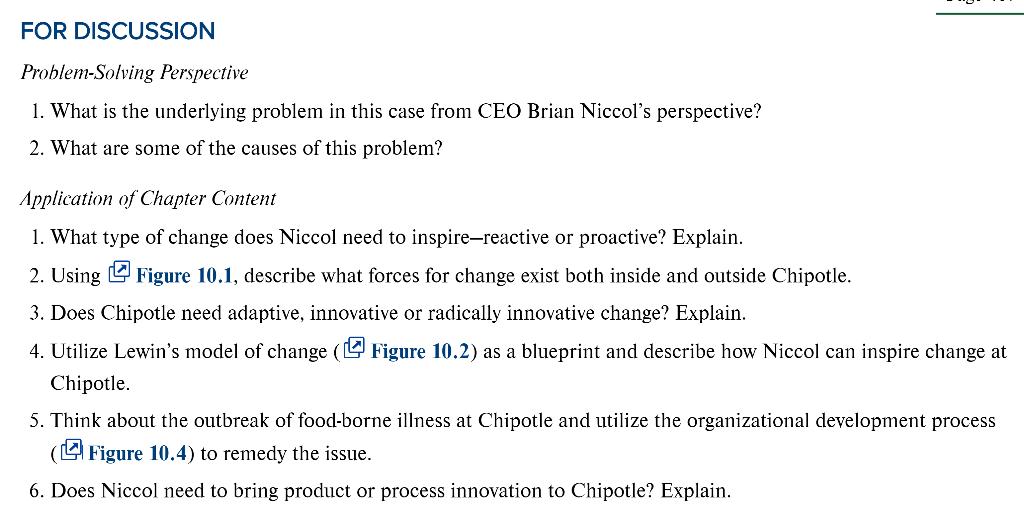
Chipotle Mexican Grill started in 1993 with a single restaurant and now operates in 2,400 locations, including in Canada, England, France, and Germany. The fast-food chain had approximately 60,000 employees and revenues of $4 billion in 2017.153 Steve Ells founded Chipotle and served as its CEO until 2018. Ells wanted to differentiate his brand from that of other fast-food chains, so he focused on fresh, high-quality raw ingredients free of antibiotics and pesticides. Meals were prepared using classic cooking methods and were served in choose-your-own style so diners could get the individual ingredients they preferred. 154 Then the company's growth and profitability were stunted by outbreaks of foodborne illnesses. Customers were sickened by E. coli, norovirus, and salmonella at dozens of Chipotle restaurants around the United States between 156 2015 and 2016.155 The restaurant's stock never recovered as shares fell nearly 60 percent between 2015 and 2018. Let's examine what led to the burrito maker's fall from grace. AS CHIPOTLE GREW, SO DID ITS PROBLEMS Chipotle rose to greatness because customers were offered a straightforward set of options, food was prepared on site in an open kitchen, and diners felt they were eating something healthy. The company had success with this model early on, but the system started to crack as Chipotle grew. Inconsistent food preparation was the first stressor. The open kitchen proved a difficult model to scale, and poor food handling most likely led to the outbreak of foodborne illness. According to the Chicago Tribune, "Chipotle has been growing too quickly, and without a game plan." The restaurant chain was plagued by inconsistency and inefficiency.157 Foodborne illnesses continued to haunt it almost two years after the initial outbreak. In 2017, "The rate of food poisoning reports attributed Page 406 to Chipotle continues to be multiples higher than peers," said Business Insider.58 These statistics are especially troubling for a brand that prides itself as providing "Food with Integrity." The restaurant's menu reflects another crack in its vision and strategies. Chipotle offers burritos, tacos, burrito bowls, and salads. This simple menu attracted customers for over a decade but is now seen as "stale," according to an analyst with the Tribune.59 Ells began offering queso in September 2017 in an attempt to spice up Chipotle's menu. The results were not promising. Only 15 percent of orders included queso, compared to the 40 percent of orders that included guacamole. Business Insider reported that queso-related traffic died off after peaking the first week the new item was available. 160 These problems have created opportunities for other fast-casual restaurants such as Qdoba and Moes, which are opening locations all over the United States. According to a UBS analyst, "... these concepts are exhibiting significant growth rates while also increasing competition for attractive market/site selection." Chipotle's once unquestionable market leadership is on shaky ground. CHIPOTLE'S NEW CEO WAS SUCCESSFUL AT TACO BELL Chipotle named Brian Niccol CEO in 2018. Niccol had been Taco Bell's chief marketing officer from 201l to 2015 before taking over as its CEo.161 He was hired at Chipotle because of the successful turnaround he had overseen at Bell. A disgruntled customer had filed a lawsuit in 2011 alleging Taco Bell's taco mixture was more filler than beef. The suit was later withdrawn, but it took a toll on Taco Bell's reputation and sales. Niccol's change efforts focused on repositioning the chain as a youthful lifestyle brand. He did this by welcoming ideas from restaurant employees and introduced new menu items, including breakfast. 162 These changes produced impressive results. Taco Bell posted an average of 4 percent sales growth during Niccol's time as CEO.163 The fast-food chain also beat out Pizza Hut and KFC as the most successful restaurant in the Yum Brands portfolio. 164 NICCOL'S CHALLENGE AT CHIPOTLE Niccol faces three challenges at Chipotle. The first is the menu and potential resistance to changing it from the company's senior leadership. The second is increased competition taking advantage of the company's past problems, and the third relates to Chipotle's food preparation practices and their contribution to foodborne illness. Niccol first needs to address Chipotle's menu problem. According to a CNNMoney analyst, "They need something that gets people talking about the brand again." The analyst says that Chipotle should consider adding new menu items such as nachos or frozen margaritas. Niccol may be positively disposed to this suggestion because he was also the architect of Taco Bell's positive move to offer breakfast and Doritos Locos tacos. 165 Other analysts have 166 concerns about the company venturing too far from its core offerings. Those who are skeptical about changing the menu include Chipotle's founder and current executive chair, Steve Ells. Ells still yields significant power and is known as a hands-on leader and perfectionist, according to The Wall Street Journal. 161 He told The New York Times, "It's not like you can put a whole new thing up on the menu board and-like at a typical fast-food place."168 This view is supported by Ells's earlier strategic failure of adding queso to the menu. Niccol is likely to experience resistance to some of his ideas because Ells does not believe Chipotle is like Taco Bell. Chipotle is more vulnerable to suppliers' changes in the price of items such as avocados and chicken. Other fast-food brands can push increased costs to franchises-something Chipotle does not have. Ells also refuses to compromise on quality as part of any change. "I don't think you're going to see a situation where someone says, 'To hell with food with integrity. We're going to buy cheap commodity meat now and really turn this thing around," he told the 169 Times. Chipotle's second challenge is increased competition, and the biggest threat here is Panera. Panera is outside Chipotle's cuisine niche, but it is competing with its promise of fresh, additive-free ingredients. It also has an exhaustive menu that rotates seasonally. Chipotle customers who are tired of its "big-four" menu will easily find a Panera nearby; Business Insider reports that 87 percent of Chipotles compete with a Panera Bread within a 10- minute drive 170 Niccol will have to do more than change Chipotle's menu if he wants to compete with Panera. He needs to address his third challenge, which is stopping people from getting foodborne illnesses at his restaurants. The new CEO might accomplish this by slowing the chain's growth and focusing on safer operations. For example, each of Chipotle's approximately 2,400 locations does its own prep work, such as washing lettuce and chopping tomatoes. 171 Although this practice is part of Chipotle's operational vision, an analyst from the Tribune suggested that "[Chipotle managers have] to keep to their core values.. .but need to find a way to be more consistent and efficient." The analyst 172 recommended that Chipotle wash and prep food in a central location and send it out to nearby stores. Such a food preparation change will significantly alter Chipotle's restaurant structure. Customers may no longer walk into a restaurant and see employees grilling meat and chopping vegetables behind the food line. This setup has been part of the chain's vision and heritage and represents something Ells holds near and dear. "Niccol will likely face an uphill battle in uprooting some of that heritage, as he's stepping into a role occupied by a founder for the past 25 years," said an analyst to Business Insider.73 Can Niccol inspire change and save Chipotle? Page 407 FOR DISCUSSION Problem-Solving Perspective 1. What is the underlying problem in this case from CEO Brian Niccol's perspective? 2. What are some of the causes of this problem? Application of Chapter Content 1. What type of change does Niccol need to inspire-reactive or proactive? Explain. 2. Using Figure 10.1, describe what forces for change exist both inside and outside Chipotle. 3. Does Chipotle need adaptive, innovative or radically innovative change? Explain. 4. Utilize Lewin's model of change (L Figure 10.2) as a blueprint and describe how Niccol can inspire change at Chipotle. 5. Think about the outbreak of food-borne illness at Chipotle and utilize the organizational development process (L Figure 10.4) to remedy the issue. 6. Does Niccol need to bring product or process innovation to Chipotle? Explain.
Step by Step Solution
3.45 Rating (152 Votes )
There are 3 Steps involved in it
Step: 1
1 Chipotle chief executive Brian Niccol faces three challenges The first is the menu and possible opposition from senior leadership at the organization to change it The second is increased competition ...
See step-by-step solutions with expert insights and AI powered tools for academic success
Step: 2

Step: 3

Ace Your Homework with AI
Get the answers you need in no time with our AI-driven, step-by-step assistance
Get Started


